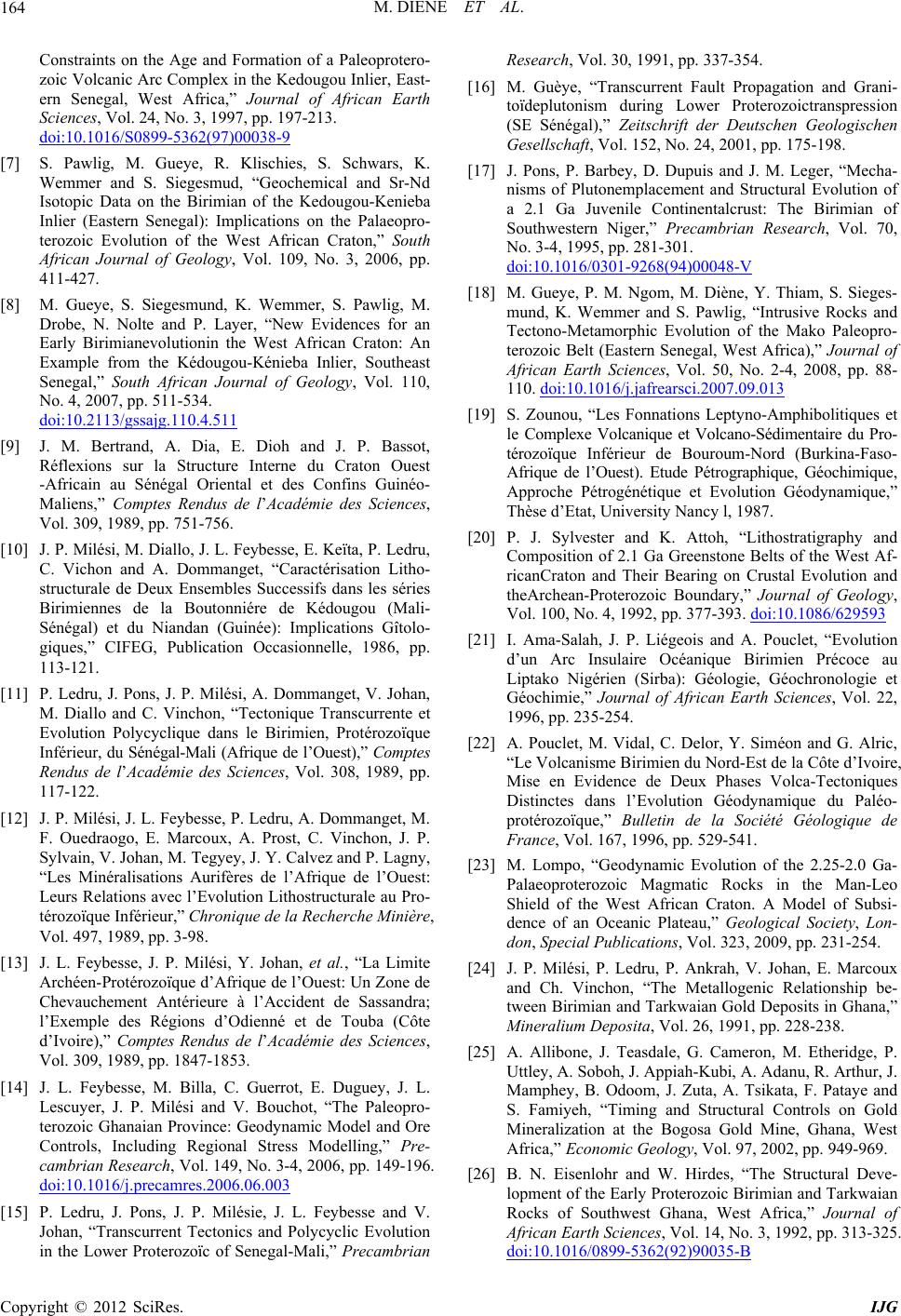
M. DIENE ET AL.
164
Constraints on the Age and Formation of a Paleoprotero-
zoic Volcanic Arc Complex in the Kedougou Inlier, East-
ern Senegal, West Africa,” Journal of African Earth
Sciences, Vol. 24, No. 3, 1997, pp. 197-213.
doi:10.1016/S0899-5362(97)00038-9
[7] S. Pawlig, M. Gueye, R. Klischies, S. Schwars, K.
Wemmer and S. Siegesmud, “Geochemical and Sr-Nd
Isotopic Data on the Birimian of the Kedougou-Kenieba
Inlier (Eastern Senegal): Implications on the Palaeopro-
terozoic Evolution of the West African Craton,” South
African Journal of Geology, Vol. 109, No. 3, 2006, pp.
411-427.
[8] M. Gueye, S. Siegesmund, K. Wemmer, S. Pawlig, M.
Drobe, N. Nolte and P. Layer, “New Evidences for an
Early Birimianevolutionin the West African Craton: An
Example from the Kédougou-Kénieba Inlier, Southeast
Senegal,” South African Journal of Geology, Vol. 110,
No. 4, 2007, pp. 511-534.
doi:10.2113/gssajg.110.4.511
[9] J. M. Bertrand, A. Dia, E. Dioh and J. P. Bassot,
Réflexions sur la Structure Interne du Craton Ouest
-Africain au Sénégal Oriental et des Confins Guinéo-
Maliens,” Comptes Rendus de l’Académie des Sciences,
Vol. 309, 1989, pp. 751-756.
[10] J. P. Milési, M. Diallo, J. L. Feybesse, E. Keïta, P. Ledru,
C. Vichon and A. Dommanget, “Caractérisation Litho-
structurale de Deux Ensembles Successifs dans les séries
Birimiennes de la Boutonniére de Kédougou (Mali-
Sénégal) et du Niandan (Guinée): Implications Gîtolo-
giques,” CIFEG, Publication Occasionnelle, 1986, pp.
113-121.
[11] P. Ledru, J. Pons, J. P. Milé si, A. Dommanget, V. Johan,
M. Diallo and C. Vinchon, “Tectonique Transcurrente et
Evolution Polycyclique dans le Birimien, Protérozoïque
Inf érie ur, du Sénégal-Mali (Afrique de l’Ouest),” Comptes
Rendus de l’Académie des Sciences, Vol. 308, 1989, pp.
117-122.
[12] J. P. Milési, J. L. Fey besse, P. Ledru, A. Dommanget, M.
F. Ouedraogo, E. Marcoux, A. Prost, C. Vinchon, J. P.
Sylvain, V. Johan, M. Tegyey, J. Y. Calvez and P. Lagny,
“Les Minéralisations Aurifères de l’Afrique de l’Ouest:
Leurs Relations avec l’Evolution Lithostructurale au Pro-
térozoïque Inférieur,” Chronique de la Recherche Minière,
Vol. 497, 1989, pp. 3-98.
[13] J. L. Feybesse, J. P. Milési, Y. Johan, et al., “La Limite
Archéen-Protérozoïque d’Afrique de l’Ouest: Un Zone de
Chevauchement Antérieure à l’Accident de Sassandra;
l’Exemple des Régions d’Odienné et de Touba (Côte
d’Ivoire),” Comptes Rendus de l’Académie des Sciences,
Vol. 309, 1989, pp. 1847-1853.
[14] J. L. Feybesse, M. Billa, C. Guerrot, E. Duguey, J. L.
Lescuyer, J. P. Milési and V. Bouchot, “The Paleopro-
terozoic Ghanaian Province: Geodynamic Model and Ore
Controls, Including Regional Stress Modelling,” Pre-
cambrian Research, Vol. 149, No. 3-4, 2006, pp. 149-196.
doi:10.1016/j.precamres.2006.06.003
[15] P. Ledru, J. Pons, J. P. Milésie, J. L. Feybesse and V.
Johan, “Transcurrent Tectonics and Polycyclic Evolution
in the Lower Proterozoïc of Senegal-Mali,” Precambrian
Research, Vol. 30, 1991, pp. 337-354.
[16] M. Guèye, “Transcurrent Fault Propagation and Grani-
toïdeplutonism during Lower Proterozoictranspression
(SE Sénégal),” Zeitschrift der Deutschen Geologischen
Gesellschaft, Vol. 152, No. 24, 2001, pp. 175-198.
[17] J. Pons, P. Barbey, D. Dupuis and J. M. Leger, “Mecha-
nisms of Plutonemplacement and Structural Evolution of
a 2.1 Ga Juvenile Continentalcrust: The Birimian of
Southwestern Niger,” Precambrian Research, Vol. 70,
No. 3-4, 1995, pp. 281-301.
doi:10.1016/0301-9268(94)00048-V
[18] M. Gueye, P. M. Ngom, M. Diène, Y. Thiam, S. Sieges-
mund, K. Wemmer and S. Pawlig, “Intrusive Rocks and
Tectono-Metamorphic Evolution of the Mako Paleopro-
terozoic Belt (Eastern Senegal, West Africa),” Journal of
African Earth Sciences, Vol. 50, No. 2-4, 2008, pp. 88-
110. doi:10.1016/j.jafrearsci.2007.09.013
[19] S. Zounou, “Les Fonnations Leptyno-Amphibolitiques et
le Complexe Volcanique et Volcano-Sédimentaire du Pro-
térozoïque Inférieur de Bouroum-Nord (Burkina-Faso-
Afrique de l’Ouest). Etude Pétrographique, Géochimique,
Approche Pétrogénétique et Evolution Géodynamique,”
Thèse d’Etat, University Nancy l, 1987.
[20] P. J. Sylvester and K. Attoh, “Lithostratigraphy and
Composition of 2.1 Ga Greenstone Belts of the West Af-
ricanCraton and Their Bearing on Crustal Evolution and
theArchean-Proterozoic Boundary,” Journal of Geology,
Vol. 100, No. 4, 1992, pp. 377-393. doi:10.1086/629593
[21] I. Ama-Salah, J. P. Liégeois and A. Pouclet, “Evolution
d’un Arc Insulaire Océanique Birimien Précoce au
Liptako Nigérien (Sirba): Géologie, Géochronologie et
Géochimie,” Journal of African Earth Sciences, Vol. 22,
1996, pp. 235-254.
[22] A. Pouclet, M. Vidal, C. Delor, Y. Siméon and G. Alric,
“Le Volcanisme Birimien du Nord-Est de la Côte d’Ivoire,
Mise en Evidence de Deux Phases Volca-Tectoniques
Distinctes dans l’Evolution Géodynamique du Paléo-
protérozoïque,” Bulletin de la Société Géologique de
France, Vol. 167, 1996, pp. 529-541.
[23] M. Lompo, “Geodynamic Evolution of the 2.25-2.0 Ga-
Palaeoproterozoic Magmatic Rocks in the Man-Leo
Shield of the West African Craton. A Model of Subsi-
dence of an Oceanic Plateau,” Geological Society, Lon-
don, Special Publications, Vol. 323, 2009, pp. 231-254.
[24] J. P. Milési, P. Ledru, P. Ankrah, V. Johan, E. Marcoux
and Ch. Vinchon, “The Metallogenic Relationship be-
tween Birimian and Tarkwaian Gold Deposits in Ghana,”
Mineralium Deposita, Vol. 26, 1991, pp. 228-238.
[25] A. Allibone, J. Teasdale, G. Cameron, M. Etheridge, P.
Uttley, A. Soboh, J. Appiah-Kubi, A. Adanu, R. Arthur, J.
Mamphey, B. Odoom, J. Zuta, A. Tsikata, F. Pataye and
S. Famiyeh, “Timing and Structural Controls on Gold
Mineralization at the Bogosa Gold Mine, Ghana, West
Africa,” Economic Geology, Vol. 97, 2002, pp. 949-969.
[26] B. N. Eisenlohr and W. Hirdes, “The Structural Deve-
lopment of the Early Proterozoic Birimian and Tarkwaian
Rocks of Southwest Ghana, West Africa,” Journal of
African Earth Sciences, Vol. 14, No. 3, 1992, pp. 313-325.
doi:10.1016/0899-5362(92)90035-B
Copyright © 2012 SciRes. IJG